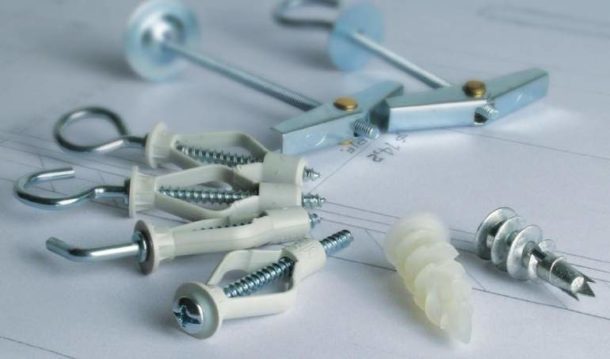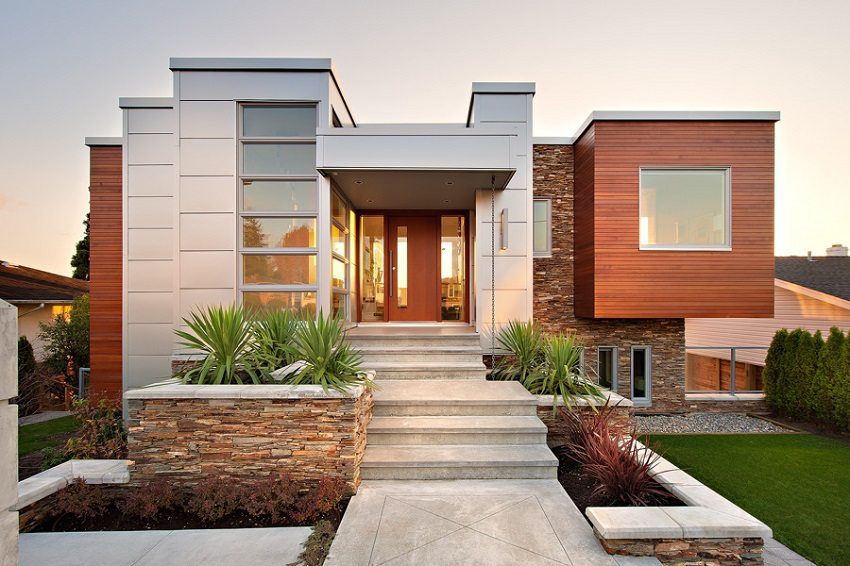Content
- Kinds
- Butterfly dowel
- Driva expansion bolt shield
- Dowel Molly
- Fischer PD
- Hartmouth from Knauf
- Dowel nails
- Spring anchor
Drywall is good in that it allows you to quickly and accurately align the walls or ceiling. But the material has one significant drawback: it is fragile and the load in the form of a wall cabinet or shelf is not designed. Traditional fastening methods in the case of GKL surfaces are unreliable: the material begins to crumble. In such a situation, a fundamentally different fastener is used - a special dowel for drywall.

Kinds
There are several types of dowels that allow you to attach hinged structures to the gypsum board:
- Butterfly.
- Plastic or metal screwdriver Driva.
- Molly.
- Fisher dowel.
- KNAUF Hartmut.
- Normal dowel-nail.
- Spring loaded.

Each of these types of fasteners has advantages and disadvantages. To understand which of them is more profitable to use in a specific situation, we will get to know them better.
Butterfly dowel
This fastener received its name because it resembles a butterfly in a tightened state. When a screw is screwed into it, the dowel wings open and abut against the surface of the drywall from the back side. To prevent scrolling of the element, special cuffs are provided.

By design, the “butterfly” can be considered as a lightweight and cheaper version of the Molly dowel.
This type of fastener is designed for small fixtures, cornices or skirting boards, fixing wiring, switches. According to manufacturers, it is able to withstand a load of up to 28 kg.

Installation instructions for butterfly dowels are simple:
- In the right place, using a drill of the appropriate diameter, a hole is made under the dowel.
- The side "wings" are compressed by hand, after which the fastener is inserted into the hole. It should go in tight, so it is recommended to use a hammer for precipitation. At the same time, the notches on the dowel body must pierce the drywall from the front side. This will prevent the item from scrolling.
- Screwing the screw in, it is necessary to tightly press the wings to the surface of the sheet on the back of the drywall.
HELPFUL INFORMATION:Drywall primer before puttying the walls: finishing instructions
The nuances of the installation of the "butterfly" are shown in the video.
The advantages of this type of mount:
- ease of installation;
- the ability to extract if necessary.
There are also disadvantages:
- For use, you need free space behind the surface of the GCR.
- The use of these dowels is limited by the thickness of the drywall coating - up to 12 mm. That is, when installing GCR in two or more layers, such fasteners will not work.
Driva expansion bolt shield
This is a metal, plastic or nylon hollow rod having a screw thread. In the head there are slots for a Phillips screwdriver.

It is more convenient to use the “Driva” type of dowel equipped with a drill. Then the installation is greatly simplified:
- Using a screwdriver, the element is screwed into the wall.
- A screw is screwed into the cross-shaped slot of the dowel, which bursts it from the inside. This ensures a solid fixation of the element in drywall.
For the Driva variety devoid of a drill at the end, a hole of 6 mm diameter is prepared in advance.

The length of the dowel made of plastic is 23 mm, but the size of the metal dies varies from 33 to 44 mm. Therefore, when choosing fasteners, the thickness of the wall is taken into account.
The main advantages of mounting "Driva":
- Low price of hardware.
- Free space behind the ceiling is optional.
- Simply dismantle if necessary.
- Plastic models are designed for loads up to 25 kg, metal - up to 35 kg.

Dowel Molly
It resembles an umbrella by its principle of action. It withstands significant loads - up to 35 kg.

The installation process is as follows:
- A hole in the wall or ceiling is drilled under the dowel diameter (usually 8 mm).
- The sleeve is inserted into the hole so that the teeth located on the cap cut into the surface. This eliminates the rotation of the fasteners.
- A screw is screwed until the opening triangles bite into the drywall from the back of the sheet, ensuring a secure fit.
HELPFUL INFORMATION:How to paint wooden floors in an apartment: a review of materials

The advantages of Molly dowels are obvious: due to the formation of a cone-shaped structure from the back of the gypsum wall, they increase the area of the support and prevent the sheet from breaking under load. The disadvantages include the high cost and the need for free space behind the gypsum board.
Note! Molly cannot be dismantled: you will have to break the wall to remove it.

And here is the Molly installation video tutorial:
Fischer PD
One of the newest and most convenient developments in the field of drywall fasteners. The principle of operation is original in that when the self-tapping screw is screwed into the dowel, its tapered shank is pressed into the plastic sleeve, forcing the wing-stops to open. With a small thickness of the sheet, they carry out pressing from the back. If the thickness of the drywall is significant, they will jam the dowel in the drilled hole.

Withstands such fasteners 12-15 kg. Installing it is simple:
- Preparing a hole in drywall.
- The dowel is inserted. The longitudinal ribs will prevent it from turning, and the reinforced flange will not allow it to fall into the hole.
- The locking screw is tightened. As it moves, the “wings” open and the dowel is fixed.

Hartmouth from Knauf
Champion among fasteners in retained weight. Able to withstand loads up to 55 kg. Consists of a metal U-shaped strip, locking bushings, and two guides made of plastic.

Installation Scheme:
- A hole with a diameter of 13 mm is drilled in drywall.
- A metal strip is introduced into it. Pulling the guides and aligning them relative to each other, it must be brought into working position.
- Guides are inserted into a colorless plastic sleeve. It is inserted into the hole until it stops.
- The ends of the guides are parted in different directions, after which they break off.
- The screw supplied is screwed into the dowel.

- Installing Hartmouth Fasteners: Step 1

- Step 2

- Step 3

- Step 4

- Step 5

- Step 6

- Back view
HELPFUL INFORMATION:How to make two-level plasterboard ceilings with backlight
The result is a very reliable fulcrum capable of withstanding solid loads.
Dowel nails
Also used when hanging light objects on drywall surfaces. Such fasteners are popular because of their convenience and low price. It is usually made of plastic, but there are also aluminum varieties.

Installation is simple:
- A hole is drilled corresponding to the thickness of the hardware.
- The plastic part is carefully hammered into it with a hammer.
- The screw shaft is also clogged with a hammer. Crosswise slots on it are provided in case you need to unscrew the screw. But it’s almost impossible to get the plastic part out of the GCR.
With all its convenience, these hardwares are used for mounting only light objects on the drywall surface.
Spring anchor
This fastener element is also called a dowel, although this is not entirely true. It is very often used to attach suspended structures, such as lamps, to the ceiling. It is a screw equipped with two stops, which are unclenched by a spring.

Mount it like this:
- A hole of the required diameter is drilled in the ceiling.
- An anchor is introduced into it, having previously folded the blades and keeping them from opening. Once behind a drywall surface, they will automatically open, providing a secure fit.

Please note that it is impossible to dismantle the spring suspension.
A competent choice of fasteners will not only ensure the reliability of fixing the hinged structures on the surface of the drywall, but also protect the gypsum board from unnecessary damage.

EXPERT SITE
Tsugunov Anton Valerevich
Master Station Wagon
- Since 2003, I have been engaged in the repair and decoration of premises.
- Over 100 completed objects.
- I appreciate the quality, more than the quantity!
Personal page >>>
Friends!
I offer you the service "Friend Builder"
As this site develops, subscribers and visitors turn to me more and more often asking for help with advice on various issues of repair and decoration.
Questions are sometimes asked very complex and interesting. You can’t write an article for each situation, so I decided to advise you individually.
Thanks to you, friends, a new direction of my favorite work has been born - share your experience and benefit everyone who is undergoing repairs!
Get a one-time consultation from me >>>
Order full apartment repair support >>>


